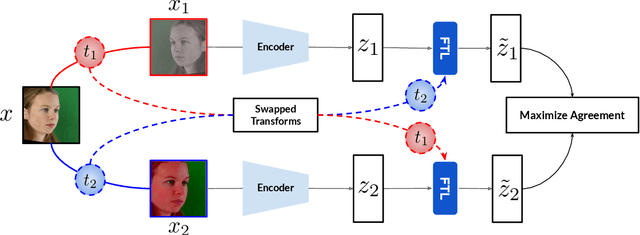Arya Farkhondeh
ChildPlay-Hand: A Dataset of Hand Manipulations in the Wild
Sep 14, 2024



Abstract:Hand-Object Interaction (HOI) is gaining significant attention, particularly with the creation of numerous egocentric datasets driven by AR/VR applications. However, third-person view HOI has received less attention, especially in terms of datasets. Most third-person view datasets are curated for action recognition tasks and feature pre-segmented clips of high-level daily activities, leaving a gap for in-the-wild datasets. To address this gap, we propose ChildPlay-Hand, a novel dataset that includes person and object bounding boxes, as well as manipulation actions. ChildPlay-Hand is unique in: (1) providing per-hand annotations; (2) featuring videos in uncontrolled settings with natural interactions, involving both adults and children; (3) including gaze labels from the ChildPlay-Gaze dataset for joint modeling of manipulations and gaze. The manipulation actions cover the main stages of an HOI cycle, such as grasping, holding or operating, and different types of releasing. To illustrate the interest of the dataset, we study two tasks: object in hand detection (OiH), i.e. if a person has an object in their hand, and manipulation stages (ManiS), which is more fine-grained and targets the main stages of manipulation. We benchmark various spatio-temporal and segmentation networks, exploring body vs. hand-region information and comparing pose and RGB modalities. Our findings suggest that ChildPlay-Hand is a challenging new benchmark for modeling HOI in the wild.
Exploring the Zero-Shot Capabilities of Vision-Language Models for Improving Gaze Following
Jun 06, 2024



Abstract:Contextual cues related to a person's pose and interactions with objects and other people in the scene can provide valuable information for gaze following. While existing methods have focused on dedicated cue extraction methods, in this work we investigate the zero-shot capabilities of Vision-Language Models (VLMs) for extracting a wide array of contextual cues to improve gaze following performance. We first evaluate various VLMs, prompting strategies, and in-context learning (ICL) techniques for zero-shot cue recognition performance. We then use these insights to extract contextual cues for gaze following, and investigate their impact when incorporated into a state of the art model for the task. Our analysis indicates that BLIP-2 is the overall top performing VLM and that ICL can improve performance. We also observe that VLMs are sensitive to the choice of the text prompt although ensembling over multiple text prompts can provide more robust performance. Additionally, we discover that using the entire image along with an ellipse drawn around the target person is the most effective strategy for visual prompting. For gaze following, incorporating the extracted cues results in better generalization performance, especially when considering a larger set of cues, highlighting the potential of this approach.
A Novel Framework for Multi-Person Temporal Gaze Following and Social Gaze Prediction
Mar 15, 2024



Abstract:Gaze following and social gaze prediction are fundamental tasks providing insights into human communication behaviors, intent, and social interactions. Most previous approaches addressed these tasks separately, either by designing highly specialized social gaze models that do not generalize to other social gaze tasks or by considering social gaze inference as an ad-hoc post-processing of the gaze following task. Furthermore, the vast majority of gaze following approaches have proposed static models that can handle only one person at a time, therefore failing to take advantage of social interactions and temporal dynamics. In this paper, we address these limitations and introduce a novel framework to jointly predict the gaze target and social gaze label for all people in the scene. The framework comprises of: (i) a temporal, transformer-based architecture that, in addition to image tokens, handles person-specific tokens capturing the gaze information related to each individual; (ii) a new dataset, VSGaze, that unifies annotation types across multiple gaze following and social gaze datasets. We show that our model trained on VSGaze can address all tasks jointly, and achieves state-of-the-art results for multi-person gaze following and social gaze prediction.
Towards Self-Supervised Gaze Estimation
Mar 21, 2022



Abstract:Recent joint embedding-based self-supervised methods have surpassed standard supervised approaches on various image recognition tasks such as image classification. These self-supervised methods aim at maximizing agreement between features extracted from two differently transformed views of the same image, which results in learning an invariant representation with respect to appearance and geometric image transformations. However, the effectiveness of these approaches remains unclear in the context of gaze estimation, a structured regression task that requires equivariance under geometric transformations (e.g., rotations, horizontal flip). In this work, we propose SwAT, an equivariant version of the online clustering-based self-supervised approach SwAV, to learn more informative representations for gaze estimation. We identify the most effective image transformations for self-supervised pretraining and demonstrate that SwAT, with ResNet-50 and supported with uncurated unlabeled face images, outperforms state-of-the-art gaze estimation methods and supervised baselines in various experiments. In particular, we achieve up to 57% and 25% improvements in cross-dataset and within-dataset evaluation tasks on existing benchmarks (ETH-XGaze, Gaze360, and MPIIFaceGaze).
 Add to Chrome
Add to Chrome Add to Firefox
Add to Firefox Add to Edge
Add to Edge